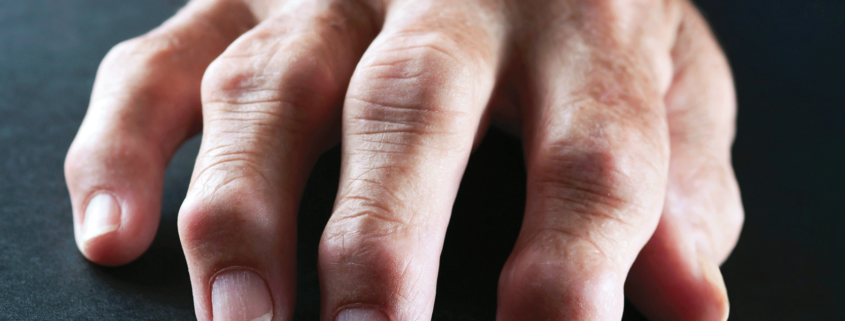Arthritis
Arthritis of the fingers can be quite uncomfortable, causing symptoms such as joint pain, swelling, and stiffness. These symptoms make hand motions like grasping and pinching difficult, which restricts a person’s ability to perform everyday tasks. Osteoarthritis (OA) and rheumatoid arthritis (RA) are the two types of arthritis that most commonly affect the finger joints. Depending on which type of arthritis affects your finger joints, you may experience additional symptoms.
Thankfully, numerous remedies can help alleviate the discomfort from arthritis of the fingers, from hand exercises to help strengthen your fingers to over-the-counter and prescription pain medications and surgical treatments.
Symptoms
With arthritis, the fingers can become swollen due to the inflamed synovial membrane. The three most common sites where osteoarthritis happens in the hand include:
- The trapeziometacarpal or basilar joint: The base of the thumb
- The distal interphalangeal (DIP) joint: The joint closest to the fingertip
- The proximal interphalangeal (PIP) joint: The middle joint of a finger
Symptoms caused by arthritis of the fingers include:
- Joint pain
- Swelling
- Stiffness, especially in the morning
- Tenderness
OA sometimes causes Heberden’s nodes, bony nodules at the end joint of the finger, and Bouchard’s nodes, bony nodules at the middle joint of the finger.
People with RA can also experience warmth and redness in the hands in addition to the symptoms listed above. RA also often affects both hands and is symmetric in nature, while OA typically affects the dominant hand only and is asymmetric in regards to joints affected, even if it is in both hands. Those with RA tend to have prolonged periods of morning stiffness compared with people with OA.
Exercises
The muscles supporting the joint of your hand can be strengthened, and hand exercises can help with that. Exercise increases blood flow to cartilage, bringing it the nutrients it needs to stay healthy and prevent further breakdown. Also, the stronger your muscles are, the more weight they can handle. The bones in your joints carry less weight, as a result, and your damaged cartilage is better protected.
The following exercises are easy to perform and can help with your arthritis pain:
- Make a fist: Start with your fingers straight and then slowly bend your hand into a fist. Make sure your thumb is on the outside of your hand. Don’t squeeze too tightly, then straighten again.
- Finger bends: Stretch your hand in front of you, palm up. Then take each finger and move it very slowly to the center of your palm. Hold it, then straighten your hand.
- Thumb bends: Bend your thumb toward your palm. Go as far as you can, hold, and then start again.
- Make a C or an O: Move your fingers like you’re going to grab a little ball, and try to form a shape of a C or an O. Go as far as you can. Straighten your fingers and repeat.
- Thumbs up: Have your hand in a loose fist with the pinky side of your hand on a table. Then point your thumb to make the thumbs up sign, put it down, and repeat.
- Finger lifts: With your hand laying on a flat surface, lift each finger one by one. Repeat the sequence for both hands.
- Wrist bends: Hold your left or right arm out with the palm facing down. Then take the other hand and gently press your whole hand down toward the floor.
- Easy squeezes: Exercises such as squeezing a rubber ball, spreading the fingers widely, and making a fist have demonstrated efficacy in reducing the symptoms of osteoarthritis.
Do these quick stretches throughout the day to build up the strength in your hands. Be mindful not to stretch your hand too far, and consult with your doctor before starting these exercises to make sure they are appropriate for you. A physical or occupational therapist can help you develop a tailored hand exercise plan that works best for you.
Exercise Is an Essential Part of Arthritis Treatment
Home Remedies
Besides exercises, you can also use a variety of oral and topical over-the-counter (OTC) medications to cope with pain from arthritis of the fingers.
Oral Anti-Inflammatory
Nonsteroidal anti-inflammatory drugs (NSAIDs) are recommended to treat arthritis symptoms because of their pain-relieving and anti-inflammatory qualities. NSAIDs can’t slow the progression of arthritis, but it can help treat pain and inflammation. You can purchase a number of NSAIDs over the counter, but some are only available as prescriptions.
Most NSAIDs work by inhibiting COX-1 and COX-2, enzymes that play a crucial role in the production of prostaglandins, which promote pain and inflammation. When fewer prostaglandins are present, less inflammation, pain, and swelling are experienced.
OTC NSAIDs commonly used to treat arthritis pain include:
- Aspirin
- Ibuprofen (Advil, Motrin)
- Naproxen sodium (Aleve)
Pain Medications for Arthritis: Strongest to Weakest
Due to adverse events in patients taking COX-2 inhibitors, including adverse cardiovascular events and stroke, the only current FDA-approved selective COX-2 inhibitor on the market is celecoxib.
Supplements
Finger pain and general discomfort are due to inflammation, and research has identified EPA (eicosapentaenoic acid) and DHA (docosahexaenoic acid) as helpful in reducing inflammation levels. This, in turn, can reduce swelling and the discomfort associated with arthritis of the fingers. EPA and DHA are omega-3 polyunsaturated fatty acids. They are found in fish and aid the body in critical development and functional needs.
Another supplement that can potentially help with arthritis pain is ginger. In a randomized, double-blind, placebo-controlled clinical trial to assess the impact of supplementing ginger for RA symptoms, disease activity and gene expression were measured in 70 participants. The study found that ginger supplementation could improve RA symptoms.




Leave a Reply
Want to join the discussion?Feel free to contribute!